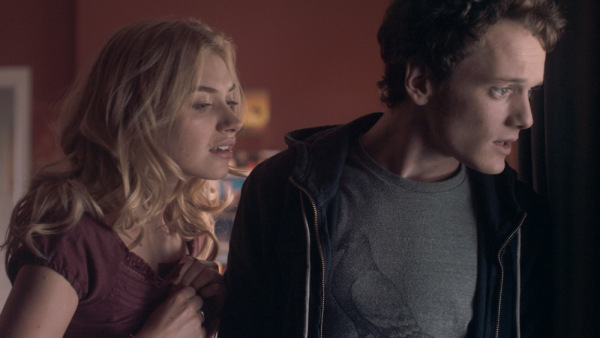Movie review by Greg Carlson
Tom Holland’s much loved 1985 vampire comedy “Fright Night” is respectably, though not spectacularly, remade with Colin Ferrell trying on Chris Sarandon’s considerably large fangs. Director Craig Gillespie and writer Marti Noxon retain the original’s hearty narrative foundation, updating a number of elements – some welcome, some not. Holland’s script, a terrific reinvention of monster maxims infused with a great understanding of classic horror movies, sharp self-awareness, and an erotic electricity almost entirely missing from the new model, proves tough to top.
Protagonist Charley Brewster (Anton Yelchin) receives a geek-chic makeover for 2011, leaving behind his friendship with childhood pal “Evil” Ed Lee (Christopher Mintz-Plasse) to run with a more popular crowd. Suspended between youthful pastimes and the strong desire to be accepted, especially by seemingly out-of-his-league girlfriend Amy (Imogen Poots), Charley’s curt dismissal of Ed’s concern over a missing classmate comes back to haunt him. The bittersweet dynamic of the withered relationship between Charley and Ed imbues the former with a caustic edge and the latter with a pitiable air of lament.
The Las Vegas setting is one of the remake’s shrewdest alterations, giving Ferrell’s Jerry Dandrige an excuse to sleep all day following night construction shifts on the Strip (or so he would like the neighbors to believe). Rows of “for sale” signs on empty split-levels allude to the post-2008 recession, and Charley’s mother Jane (Toni Collette) is a Century 21 real estate agent whose extra yard signs come complete with handy stakes once Charley’s outrageous claims concerning Jerry’s vampirism are believed. The Sin City setting also makes room for the transformation of Charley’s savior Peter Vincent (David Tennant) from washed up actor/late night horror host into flashy Criss Angel-by-way-of-Russell Brand stage illusionist. While Roddy McDowall’s indelible Vincent can’t be bettered, Tennant holds his own, transcending the deliberately tacky outrageousness of the new model with smarts and timing. Too bad he wasn’t given a bit more to do.
Missing from the remake is Jerry’s manservant/roommate Billy Cole, and while the downsizing/streamlining of two characters into one is in keeping with Ferrell’s loner menace (described by the filmmakers as a deliberate homage to the killer shark in “Jaws”), the movie loses an intriguing homoeroticism inherent in the original friendship. The remake’s only significant same-sex connection occurs during the weirdly poignant “turning” of Ed by Jerry in a swimming pool, a scene evocative of both baptism and the loss of virginity.
The popularity of the vampire, particularly among young audiences, exploded anew with the “Twilight” series (acknowledged in “Fright Night” by longtime “Buffy the Vampire Slayer” scribe/producer Noxon in a tart aside), but the genre’s durability extends well beyond the icy chivalry of Edward Cullen. Jerry Dandrige, whose ravenous appetite for Amy in the original “Fright Night” was explained by her resemblance to a long lost love, now taunts Charley with coarse allusions to predatory wish fulfillment (Charley’s sexual hang-ups provide subtext in both versions), but beyond recognizing Amy as “ripe,” the new Jerry doesn’t distinguish her from any of his other victims. A side-by-side comparison of the dance club sequences testifies to the superiority of Holland’s vision and the importance of forging a real Charley-Jerry-Amy triangle. Despite Ferrell’s winking sultriness, the first “Fright Night” is still the real thing.
